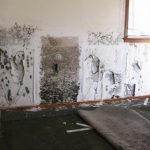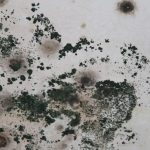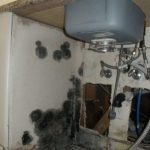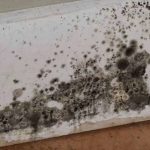Have you noticed something strange on your home ceiling like the shade of the walls begin fading and is dotted by darkish plant-like living being?
The smudge is the formation of mold. It comes out as you probably encounter water damage – the leaks in the pipe or a leaking roof must be troublesome.
Tips to get rid of water damage mold smell
The fungus thriving in the warm, humid, and dim spot doesn’t only impact on the interior’s look, but the musty odor is inescapable.
To deodorize the affected area of your house, you can take these following steps mainly to clear the odor away:
- Find the source of water damage like the damp spot in the entire of your house.
- If you find the spot overgrown by the stubborn mildew is simply walking distance from you (less than 10 square feet), the right action should be scraping the surface with the aid of cleaning solution like water and detergent.
- Never apply the bleach – the chemical does kill the active mold yet not for rooting the mold spores.
- Hire a professional from the mold removal company if the reaching area is more than 10 square feet.
- To dry the affected area already cleaned up, you better use some mold removing appliances such as air-moving fans and dehumidifiers.
If the professional finds that there should be other possibilities other than water damage mold, you can use an effortless method.
The annoying stench from the carpet could be discarded with the baking soda – just place it under the rug overnight.
For the upholstery, you are encouraged to apply the solution made up of white vinegar and spritz.
Is water damage mold hazardous to your health?

People who get the exposure of water damage mold can get infected by certain illnesses and miserable symptoms.
Several health problems commonly have a close relation to allergies or immune system-related disease.
Some other immunologic reactions would be somehow more severe if the sufferers are not in proper handling.
The mold spores even can cause serious illness related to the respiratory systems such as allergic fungal sinusitis, bronchial asthma, allergic conjunctivitis, allergic rhinitis, and urticaria.
Other serious diseases like pneumonia and ABPA (Allergic Bronchopulmonary Aspergillosis) can’t be taken for granted. Living in an area with high humidity is pretty risky.
How to prevent mold after water damage
There are some ways when it comes to preventing the water damage mold:
- Locate the problem source why the water damage mold appears. It’s pronounced when a natural disaster like hail and flood often occurs and affects your house, investigating the roof leak or crack on the wall is such an awesome step to anticipate the matter of fungus spread.
- Never let the water comes in. It must be something irritating when the home pipe is leaky. Once you find this issue, fix it directly. Repairing the water-damaged floorboard surely prevents the water spurting out so that the mold growth is avoidable.
- Cut out the excess water. It seems a bit overwhelming dealing with the overage water – wiping it up is likely not enough. To take out the additional liquid, you might benefit both the shop vac (a specially designed vacuum cleaner) and fans. A pump for an advanced way is also recommended.
- Take off the moldy objects at your home. To keep away the dissemination of mildew spores, the tricky way would be removing the household objects overgrown by the organism that includes furniture, drywall, painting, and drywall. Be sure to put on protective equipment like mask and gloves while transferring them.
- Replace the water-damaged objects soon. We know that the mold loves showing up in a humid area. Once water has damaged your household materials, a method to anticipate the living being is to replace them directly.
- Use the fungicide product to get rid of mold. Some people might assume that cleaning up with the bleach is the sole effective solution. However, don’t you know that the chemical is not environmentally friendly?
- After fixing some problems related to water-damaged rooms, you are obviously encouraged to make some improvements to prevent the mold spreading in the future. For instance, instead of putting down a tapestry on the floor, you can install the tile flooring.
How to remove water damage mold
Another issue dealing with the cleaning up the water damage must be the approaches to remove the mold.
To stop the fungus growth, you need to follow these steps:
- Clear out all types of dampness. You have to understand that why the mold exists is due to the role of the moisture. Thus, extracting all moisture is an initial step to tackle the trouble. To do this, you can turn on the dehumidifier. Make sure to empty the holding tank before applying the machine – the space will be filled with water comprising of mold spores.
- Clean up the vast surfaces. As the mold and its spores have scattered across the wall and floor, you need to take the moist carpet outside under the sun exposure. Then, make a cleaning solution that consists of chlorine bleach and warm water. Wipe the wall and mop the floor with the mixture. Repeat this step each 2 to 3 day.
- Cleanse the wooden furniture such as wardrobes, chairs, tables, and book shelves. To apply this method, be sure to drop a little of denatured alcohol on a scrap of cloth then rub it on the wood surface gently. Once you finish doing it, let the liquid dry for a couple of minutes then spray the disinfectant to prevent the growth of bacteria.
- To treat the fabric items, an effective way to discard the mold is scrubbing them with a soft brush. Once, you’ve done with the brushing thing, let the items under the scorching sun for a day then spray with the disinfectant.
In conclusion, there is nothing be concerned about when it comes to dealing with the water damage and mold. The steps of removing the mold smell to extracting the fungus are informative and helpful.






